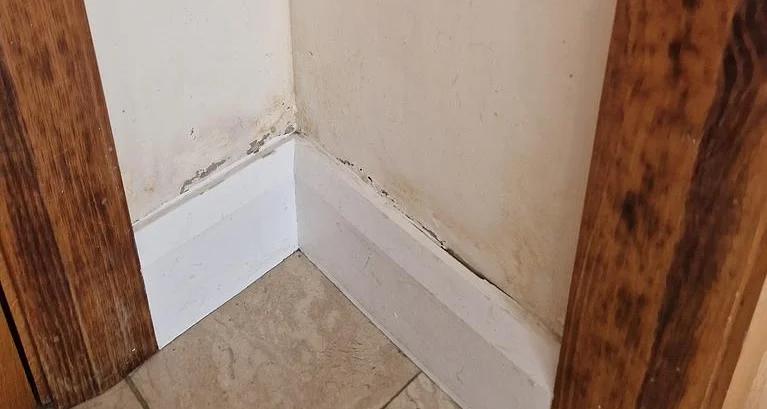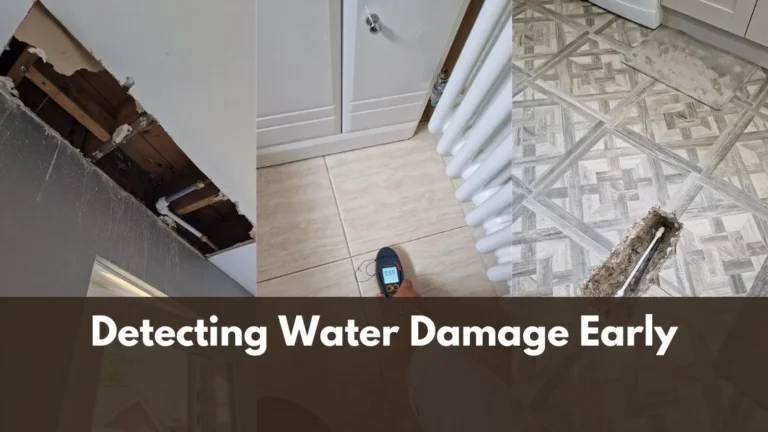Detecting water damage early is critical to preserving your home’s integrity. Key indicators include visible signs such as yellow or brown water stains, peeling paint, and warped flooring.
Physical changes in walls and ceilings, alongside musty odours, often suggest hidden moisture and potential mould growth. Common vulnerable areas include kitchens, bathrooms, and basements, where leaks frequently occur.
Regular inspections and prompt leak repairs can mitigate significant damage. Employing water sensors in high-risk zones can also provide proactive alerts.
Understanding these indicators is essential for timely intervention and safeguarding your property against costly issues down the line. Read on to find out more.
Key Takeaways
- Look for visual signs such as water stains, peeling paint, and efflorescence to identify potential water damage early.
- Monitor for physical changes, including warped floorboards and soft spots in walls or ceilings.
- Detect musty odours, which often indicate hidden mould growth and should be addressed immediately.
- Conduct regular inspections of vulnerable areas such as kitchens, bathrooms, and basements at least twice a year.
- Install water leak sensors in high-risk areas to receive early warnings of leaks and potential water damage.
Understanding Water Damage
Water damage is a common problem that can quietly wreak havoc on your home. It usually comes from everyday issues like plumbing leaks, broken appliances, or a faulty roof. If left unchecked, this kind of water can cause serious damage to your home’s structure.
It’s important to know about the three types of water damage: Clean Water, Grey Water, and Black Water. Understanding these helps you assess the damage better. If water is left too long, it can do more than just ruin your property—it can lead to health issues, like mould growth, which can make breathing problems worse.
| Type of Water | Description | Examples | Potential Risks |
|---|---|---|---|
| Clean Water | Water from a sanitary source that doesn’t pose an immediate health risk. Typically safe if dealt with quickly. | Burst pipes, rainwater, and overflow from sinks or bathtubs. | Minimal risk if addressed promptly; may lead to structural damage or mould growth over time. |
| Grey Water | Water that is slightly contaminated and may contain chemicals, soaps, or other impurities. Can cause illness if ingested. | Water from dishwashers, washing machines, or aquariums. | Can lead to bacterial growth and cause illness; needs quick cleanup to avoid further contamination. |
| Black Water | Highly contaminated water that poses serious health risks, containing harmful bacteria, chemicals, or pathogens. | Sewage backups, flooding from rivers, or stagnant water. | Severe health risks, including illness from pathogens; requires professional remediation and full decontamination. |
Regular inspections of vulnerable areas like kitchens, bathrooms, and basements can identify early signs of moisture issues, allowing homeowners to mitigate potential damage and maintain a safe, healthy living environment.
Taking proactive steps to address water issues as soon as they arise is key to avoiding costly repairs down the road. Simple actions like fixing leaks promptly, ensuring proper ventilation, and maintaining gutters and downspouts can significantly reduce the risk of water damage. By staying vigilant and acting quickly, you can protect both your home’s value and your family’s well-being.
Key Indicators of Water Damage
Identifying key indicators of water damage is essential for early intervention and the prevention of further issues.
Visual signs such as water stains, peeling paint, and efflorescence, alongside physical changes like warped floorboards, can reveal hidden moisture problems.
Recognising these symptoms promptly allows homeowners to address potential water intrusion before it escalates into more significant damage.

Visual Signs to Observe
While many homeowners may overlook subtle clues, recognising the visual signs of water damage is essential for preventing more extensive issues. Key indicators include water stains on walls and ceilings, often appearing as yellow or brown discolourations. Peeling paint or bubbling wallpaper suggests moisture presence behind surfaces. Musty odours can reveal hidden mould growth, while warped or buckling flooring points to prolonged exposure to water. Furthermore, soft spots in walls or ceilings indicate underlying damage that may compromise structural integrity.
| Indicator | Description | Action Needed |
|---|---|---|
| Water Stains | Yellow/brown discolourations | Investigate for leaks |
| Peeling Paint | Moisture behind surfaces | Repair and dry area |
| Musty Odours | Potential mould growth | Inspect and mitigate |
| Warped Flooring | Prolonged water exposure | Assess and replace if needed |
Common Vulnerable Areas
Water damage can silently wreak havoc in various parts of a home, often targeting areas frequently exposed to moisture.
- Kitchen: The kitchen is vulnerable due to leaks from dishwashers, sinks, and fridges. Regularly checking these appliances can help notice damage early and prevent it from getting worse.
- Bathroom: Bathrooms contain numerous water pipes, making leaks from sinks, toilets, and showers more likely. Regular inspections are crucial to catch any hidden damage.
- Utility Room: Utility rooms, often containing boilers, water heaters, and other plumbing connections, are at risk of leaks or equipment failure. Regular maintenance of these systems can help prevent potential water damage.
- Exterior Areas: Gutters, downspouts, and exterior drainage systems can also contribute to water damage if they are blocked or damaged. Regular cleaning and maintenance can help prevent water from seeping into the home.
Being vigilant in these vulnerable areas can significantly reduce the risk of water damage and keep your home safe.
Sources of Water Damage
Understanding the common vulnerable areas of a home is key to identifying the diverse sources of water damage that can occur.
Burst or leaking pipes are a common cause of water damage, particularly during colder months when pipes are prone to freezing. Addressing these issues quickly can help prevent major structural problems.
Appliance malfunctions, such as from washing machines or dishwashers, are another common risk, often resulting in unexpected water leaks. These incidents can lead to a lot of damage if not managed quickly. In addition, poor drainage systems around the property can lead to water pooling near the foundations, increasing the risk of damp and structural damage.
In the UK, heavy rainfall and localised flooding are also major contributors to water damage. When drainage systems become overwhelmed, water can enter basements, ground floors, or other vulnerable parts of the property, leading to severe consequences if not mitigated swiftly.
During the Halloween weekend of 2023, severe flooding impacted areas around Downpatrick, Portadown, and Newry. PCLA were called upon to represent numerous property owners whose homes and businesses suffered significant damage. The estimated cost of damage to these properties ranged from £50,000 to £100,000.
Recognising these potential sources of water damage is crucial for effective prevention and timely intervention.
Preventive Measures
Implementing preventive measures is essential in safeguarding your home from water damage.
Regular inspections of vulnerable areas, coupled with prompt leak repairs, can significantly reduce the risk of extensive damage.
Furthermore, installing water sensors in key locations provides an early warning system, allowing for swift action when issues arise.
Regular Inspections Essential
Regular inspections are a critical component in safeguarding homes from potential water damage. Establishing an inspection frequency of at least twice a year, particularly in vulnerable areas such as kitchens, bathrooms, and basements, can greatly mitigate risks.
Employing effective inspection techniques, such as using moisture meters, allows for accurate detection of hidden moisture.
Consider the following preventive measures:
- Monitor for discolouration or peeling paint.
- Schedule seasonal checks to catch early signs.
- Clean gutters and downpipes regularly.
- Educate household members on signs of water damage.
- Report any musty odours or soft spots immediately.
Prompt Leak Repairs
Timely repairs of leaks are essential in preventing water damage and preserving the integrity of a home. The urgency of leak detection cannot be overstated; addressing issues promptly can thwart significant structural damage or mould growth. Learn more about the consequences of water leaks in your home.
Regular inspections of plumbing fixtures, such as sinks and toilets, should become a routine practice, focusing on signs of rust, corrosion, or dripping. Furthermore, maintaining appliances like washing machines and dishwashers by checking hoses and connections reduces leak risks.
Any visible water stains or dampness on walls and ceilings must be addressed immediately, as they often signal hidden leaks. Establishing a routine inspection schedule for vulnerable areas, including basements and lofts, guarantees quick repairs and minimises the risk of extensive damage.
Install Water Sensors
Beyond prompt leak repairs, the integration of water sensors into a home’s infrastructure offers a groundbreaking layer of protection against water damage.
By employing advanced sensor technology, these devices can detect leaks early, alerting homeowners to issues before they escalate. Installing water sensors in high-risk areas such as basements, kitchens, and bathrooms is essential.
- Detects minor humidity changes
- Sends real-time alerts via Wi-Fi
- Affordable options range from £30 to £150
- Guarantees immediate action, even remotely
- Requires regular testing for reliability
Installation tips include placing sensors on floors near water sources and testing them regularly to ensure effective operation.
Embracing water sensors fosters a proactive approach, safeguarding your home and providing invaluable peace of mind.
Importance of Professional Help
Engaging professional help for water damage detection and remediation is essential for safeguarding your property.
Professionals conduct an expert assessment that uncovers hidden issues, such as structural weaknesses and trapped moisture, often invisible to homeowners. Their specialised tools and knowledge enable them to classify water damage accurately—whether clean, grey, or black—ensuring the correct restoration methods and safety measures are employed.
Moreover, professional mould remediation is vital to prevent health risks associated with mould exposure, as experts can identify mould types and implement safe removal techniques.
Prompt intervention by professionals not only minimises long-term structural impact but also greatly reduces repair costs.
In addition, many restoration services offer warranties and insurance support, providing homeowners with peace of mind and assistance with claims processes.
Concerned about water leaks causing damage to your property?
Northern Ireland’s premier Leak Detection Service specialises in finding and fixing water leaks to protect your home or business!
Consider the potential damage a water leak can cause—escalating bills, structural issues, and harmful mould growth. Our expert team employs cutting-edge technology to detect water leaks quickly and accurately, saving you from expensive repairs and unnecessary stress.
Imagine the peace of mind you’ll feel knowing your property is free from water leaks. Don’t let water leaks turn into costly problems.
Contact Northern Ireland’s most trusted Leak Detection Service specialising in water leaks today.



